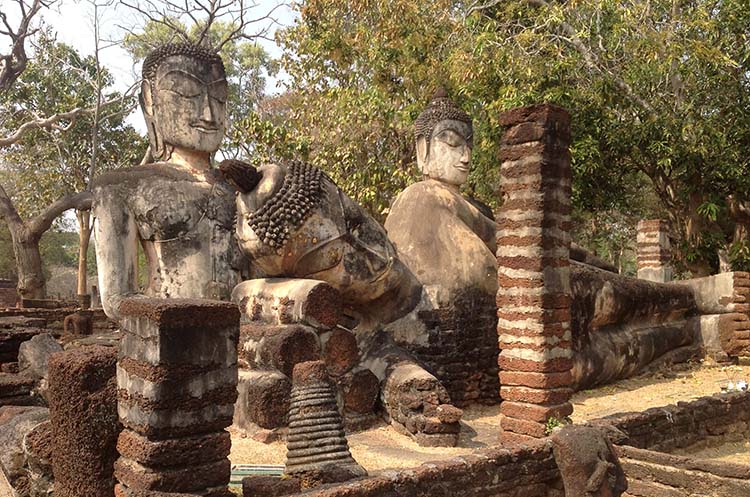
Kamphaeng Phet Historical Park
Garrison town of the Sukhothai Kingdom
The Kamphaeng Phet Historical Park contains the ruins of the ancient town of Kamphaeng Phet, an important town in the Sukhothai Kingdom. The park that is little visited by foreign tourists contains monuments built during the 13th to 17th centuries by the Sukhothai and Ayutthaya empires.
“Wall of diamonds”
The city of Kamphaeng Phet derives its name from the ancient walls protecting it. Kamphaeng Phet translates to “wall of diamonds”.
The town was an important part of the defense system of the Sukhothai Kingdom. Kamphaeng Phet was a “wang” or garrison town to protect the capital Sukhothai from invasion by Burmese armies. The town was situated in a strategically important location and was well protected with a system of moats, city walls with watchtowers and fortresses.
During the reign of King Luethai the town was moved to the East of the Ping river and its named changed to Cha Kang Rao.
Under control of Ayutthaya
Later when the power of the Sukhothai Kingdom had faded and the town was under control of the Ayutthaya Kingdom, Kamphaeng Phet served as a garrison town to protect the capital Ayutthaya.
UNESCO World Heritage Site
Kamphaeng Phet Historical Park is one of the three parks that together make up the UNESCO World Heritage Site “Historic town of Sukhothai and associated historic towns”, the other two being Si Satchanalai and the capital Sukhothai.
Royal Palace & temples
Spread out over several sites on both sides of the Ping river are the remains of a great number of temples built during the Sukhothai and Ayutthaya eras.
The Kamphaeng Phet Royal Palace was located next to the Wat Phra Kaew temple near the Northern city wall in the central zone. It was surrounded by an earthen wall, in turn surrounded by a moat. Today virtually nothing remains of the palace buildings.
Kamphaeng Phet National Museum
Kamphaeng Phet National Museum exhibits artifacts found during excavations around several sites in Kamphaeng Phet, including ceramic wares, Buddha images from several eras as well as items excavated in several sites across the province that go back to prehistoric times. One of its most interesting items is an early 16th century bronze statue of Shiva measuring 2.10 meters high that was originally kept in the nearby Shiva shrine. An inscription on the base says the image was made by order of the Kamphaeng Phet King in 1510 to protect the town’s inhabitants.
The Kamphaeng Phet National Museum is located near the Wat Phra That temple within the old city walls of the central area. The museum opens Wednesday through Sunday, from 9 am until 4 pm. Admission is 100 Thai Baht.
How to get to Kamphaeng Phet Historical Park
Kamphaeng Phet Historical Park is found in Kamphaeng Phet town about 355 kilometers North of Bangkok and about 80 kilometers South West of Sukhothai Historical Park. The easiest way to get there from the town center is by songthaew or on a rented bicycle. For ways to get to Kamphaeng Phet from Bangkok or Sukhothai, see “Getting to Kamphaeng Phet”.
Getting around in the park
The central area East of the Ping river that contains some of the most important temples as well as the Kamphaeng Phet National Museum is small enough to be explored on foot. A fun way to get around the park is on a bicycle. Bikes can be rented at the gates of the central city area and Aranyik area or at several hotels and shops near the park at 50 Baht per day. To get from one zone to the next, hire a car with driver or a songthaew through hotel.
Admission & opening hours
The historical park opens daily from 8 am until 5 pm. The visitor center opens from 8:30 am until 4:30 pm. The central area and Aranyik area charge a separate admission fee of 100 Thai Baht each, plus 10 Baht for a bicycle or 50 Baht for a car.
Kamphaeng Phet temples
- Wat Phra That
- Wat Phra Kaew
- Wat Avasa Yai
- Wat Singha
- Wat Chang Rop
- Wat Phra Non
- Wat Phra Si Iriyabot